#arthrodire
Text
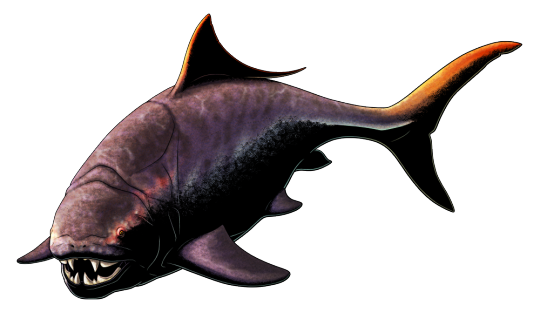
With its armored head and blade-like jaws, the placoderm fish Dunkleosteus terrelli is an iconic Paleozoic animal.
Living during the Late Devonian, about 375-359 million years ago, in subtropical waters covering parts of what are now North America and Europe, this species is known mostly just from the bony plates that covered its head and thorax. The rest of its skeleton was cartilaginous and rarely ever fossilized (only a few vertebrae and the pectoral fin are currently known), so its full body shape and size is poorly understood, and previous length estimates have ranged all the way up to 10m (33').
…Except it turns out it wasn't nearly that big.
Based on its head proportions, along with comparisons to more complete remains of other arthrodire placoderms, recent studies instead come up with a maximum length of about 4m (~13ft) – giving Dunkleosteus a much shorter-but-heavier chunky body shape, more like a tuna than a shark.
But even after this size revision Dunkleosteus would have still been one of the largest animals around at the time, with the ability to snap its jaws open at high speed and an incredibly strong bite force. It was probably specialized to mainly prey on other heavily-armored animals such as other placoderms and shelled cephalopods, and was likely a strong swimmer with a shark-like tail fin.
Preserved stomach contents in one fossil show remains of the fast-swimming cartilaginous fish Orodus – suggesting that much like the modern tuna it resembled, Dunkleosteus was also capable of bursts of high speed.
———
NixIllustration.com | Tumblr | Twitter | Patreon
#science illustration#paleontology#paleoart#palaeoblr#dunkleosteus#dunkleosteidae#arthrodire#placoderm#fish#art#chunkleosteus#big chonk#a very shaped animal#gotta go fast
890 notes
·
View notes
Text

2-6-23
#moleskine#sketchbook#sketch#daily#dailyart#dailydrawing#dailypainting#dailysketch#sketchaday#artoftheday#art#artbook#artists on tumblr#watercolor#gouache#painting#fineliner#drawing#dunkleosteus#arthrodire#placoderm#devonian#fish#fossil#head
328 notes
·
View notes
Text

It’s been quite a year since Dunkleosteus terreli, the 4.5-meter-long King of the Placoderms that had the most powerful bite force of any fish living or extinct, made news with to this groundbreaking study:
#paleoart#paleontology#dunkleosteus#devonian#marine paleontology#sea monster#placoderm#ammonite#paleozoic#paleoillustration#palaeoblr#palaeontology#palaeoart
52 notes
·
View notes
Note
Jhonen Vasquez is a dick

Dunkleosteus is an extinct genus of large arthrodire ("jointed-neck") fish that existed during the Late Devonian period, about 382–358 million years ago. It was a pelagic fish inhabiting open waters, and one of the first apex predators of any ecosystem.[1]
Dunkleosteus consists of ten species, some of which are among the largest placoderms ("plate-skinned") to have ever lived: D. terrelli, D. belgicus, D. denisoni, D. marsaisi, D. magnificus, D. missouriensis, D. newberryi, D. amblyodoratus, D. raveri, and D. tuderensis. The largest and best known species is D. terrelli. Since body shape is not known, various methods of estimation put the living total length of the largest known specimen between 4.1 to 10 m (13 to 33 ft) long and weigh around 1–4 t (1.1–4.4 short tons).[2] However, lengths of 5 metres (16 ft) or more are poorly supported and the most extensive analyses support smaller size estimates.[2][3]
Dunkleosteus could quickly open and close its jaw, creating suction like modern-day suction feeders, and had a bite force that is considered the highest of any living or fossil fish, and among the highest of any animal. Fossils of Dunkleosteus have been found in North America, Poland, Belgium, and Morocco.
14 notes
·
View notes
Text
Diversity | Free Full-Text | A Devonian Fish Tale: A New Method of Body Length Estimation Suggests Much Smaller Sizes for Dunkleosteus terrelli (Placodermi: Arthrodira)
SHORT DUNK SHORT DUNK SHORT DUNK

75 notes
·
View notes
Text

I almost forgot to post these--but I finally got Hymn and Kairi's field uniforms finished! These are the uniforms they'd wear on raids and such in the kingdom with Mack.
I'll include some notes and explanations for design choices below the cut, and add these to their muse pages when I get home from work 👍
All employees under Mackentire sport animal skull masks; the Fleshlings have horse skull masks (modified to have sharp canines for the intimidation factor), while the Labrats have rat skull masks. (These masks are obviously not taken from the animals of the same names, but custom made and fit to the head of the individual wearing it).
Anyone who does fieldwork with Mack is required to wear additional armor. All of the fleshlings have matching uniforms which include the following; a skull mask, and chest armor, pelvic armor, shoulder pauldrons, and gauntlets over the forearms and shins, all with a navy blue color scheme and orange accents.
However, 'elite' members are allowed to tweak and customize their fits, so long as there is adequate coverage to keep vital organs safe. They may also select their own animal for their skull mask to be modeled after.
Now that we've gotten all of tghat out of the way, let's get into Hymn and Kairi's individual uniforms!
Hymn Nikolaou, alias "The Siren"
Hymn has modified his uniform to be slightly more streamlined and lightweight to accommodate his fighting style, and possible combat in water. His bodysuit has mesh cutouts around his gills for easy breathing when under water. In addition to using his voice and bare hands for combat, his gauntlets have long blades attached for slashing attacks.
His mask is modeled off of the Dunkleosteus, an extinct genus of large arthrodire (jointed neck) fish that existed during the Late Devonian period. He chose this creature for it's reputation as one of the first marine apex predators, and stories told to him by his mother growing up of ancient sirens who hunted them and used their bones for armor and weapons.
Hymn is the only member who does not have any additional covering over his mouth.
Kairi M. Scott, alias "The Scarecrow".
Kairi modified her uniform to allow for more range of motion to accommodate her mixed martial arts style of fighting, which relies mostly on quick punches and powerful kicks. She wears additional wrapping and plating on her hands with bone protrusions below her knuckles, for extra protection when punching and for pin-point damage. She wears a belt with two harnesses attached; Around her waist are various mixtures and powders that she makes herself within the lab, with the following intentions; Green serum for health/quick healing, blue powder for paralysis, red serum for a temporary boost to all 'stats', and a purple powder for poison. On either thigh she has holsters for her handheld weapon of choice, two switchblade scythes.
Her mask is modeled off of a Jacob's sheep skull, a piebald and often polycerate (multi-horned) domestic breed. She chose this animal for it's unique horns, and a reclamation of being called 'the black sheep' of her family by her mother growing up. Despite the association with 'sheep' being 'followers' at the mercy of their shepherds, she sees herself less of a follower keeping her head down and doing as she is told and more of a wolf wearing a sheep's skin to protect the flock from within. This further plays into her choice of alias 'scarecrow', which was taken from the name of decoys made by farmers in the shape of a man and often stuffed with hay or straw to scare away birds and wildlife from their crops, thus watching over or 'protecting' the fields.
Kairi additionally wears a black hood over her bodysuit which attaches to her mask to hide her blonde hair, which could lead someone to discovering her true identity.
Individual images:
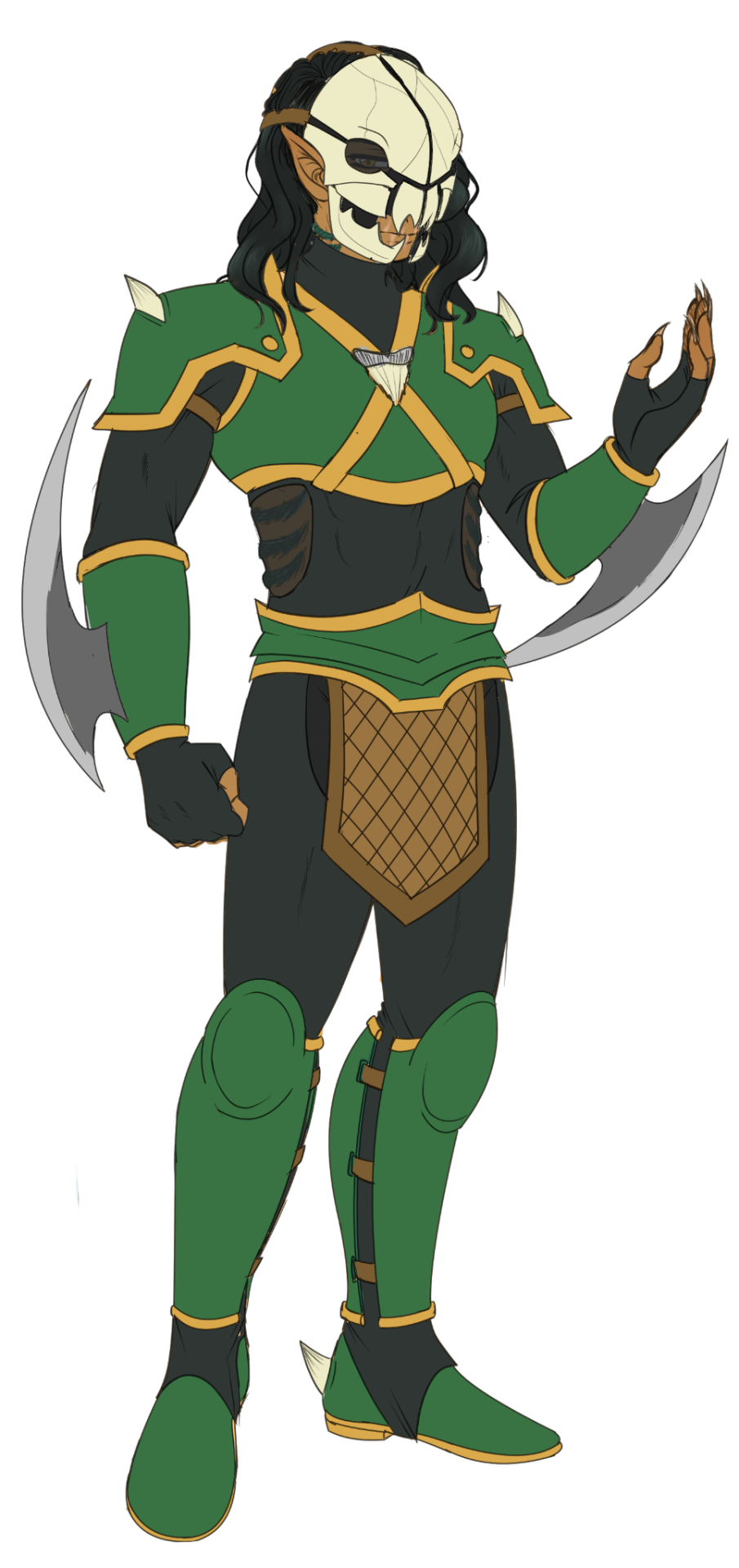

#oc ref#muse ref#character ref#headcannons#world building#universe building#armor#cw: animal skull#the scarecrow (save slot a kairi)#herald of the deep (save slot a hymn)#art#mun art#my art#muse art#oc art#oc
12 notes
·
View notes
Text

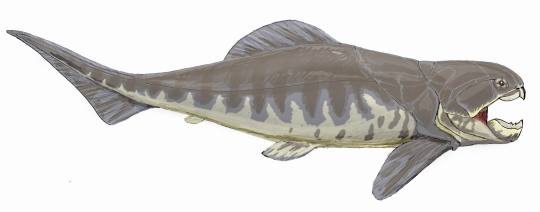
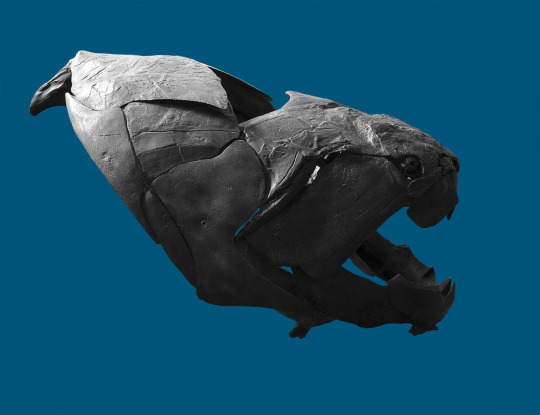

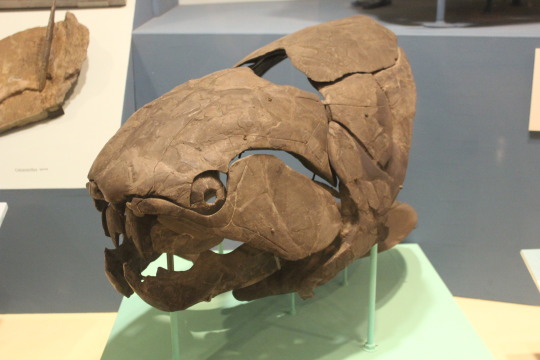

Dunkleosteus
(temporal range: 382-358 mio. years ago)
[text from the Wikipedia article, see also link above]
Dunkleosteus is an extinctgenus of large arthrodire fish that existed during the Late Devonian period, about 382–358 million years ago. It consists of ten species, some of which are among the largest placoderms to have ever lived: D. terrelli, D. belgicus, D. denisoni, D. marsaisi, D. magnificus, D. missouriensis, D. newberryi, D. amblyodoratus, D. raveri, and D. tuderensis, and the largest and most well known species is D. terrelli. Since body shape is not known, various methods of estimation put the living total length of the largest known specimen between 4.1 to 10 m (13 to 33 ft) long and weigh around 1–4 t (1.1–4.4 short tons).[1]Dunkleosteus could quickly open and close its jaw, like modern-day suction feeders, and had a bite force of 4,414–6,170 N (450–629 kgf; 992–1,387 lbf) at the tip and 5,363–7,495 N (547–764 kgf; 1,206–1,685 lbf) at the blade edge.[2][3] Numerous fossils of the various species have been found in North America, Poland, Belgium, and Morocco. Dunkleosteus was a pelagic fish inhabiting open waters, and an apex predator of its ecosystem.
22 notes
·
View notes
Note
Whats a mun again. I forgot what that was
A “Mun” Is an Extinct Genus of “large” arthrodire Fish That existed during The “late Devonian” period, about 382-358 Million years Ago. Saw one “swimning” in the Higan “once”...
I sent our mun to the basement to deal with the vermin and he never came back. -S.Komeiji
4 notes
·
View notes
Text
We found the oldest ever vertebrate fossil heart. It tells a 380 million-year-old story of how our bodies evolved
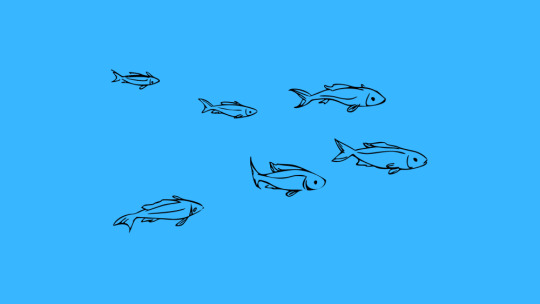
- By Kate Trinajstic , John Long , The Conversation -
In the limestone ranges of Western Australia’s Kimberley region, near the town of Fitzroy Crossing, you’ll find one of the world’s best-preserved ancient reef complexes.
Here lie the remnants of myriad prehistoric marine animals, including placoderms, a prehistoric class of fish that represents some of our earliest jawed ancestors.
Placoderms were the rulers of the ancient seas, rivers and lakes. They were the most abundant and diverse fishes of the Devonian Period (419–359 million years ago) – but died out at the end in a mass extinction event.
Studying placoderms is important as they provide insight into the origins of the jawed vertebrate body plan (vertebrates are animals with backbones). For instance, placoderms have revealed when the first jaws, teeth, paired skull bones and paired limbs evolved. They’ve also taught us about the origins of internal fertilisation and live birth in vertebrate evolution.
Now, in a paper published in Science, we detail our findings of the oldest three-dimensionally preserved heart from a vertebrate – in this case a jawed vertebrate. This placoderm heart is about 380 million years old, and 250 million years older than the previous oldest vertebrate heart.

The 3D preserved heart of a placoderm fish from Gogo. The rock entombs the bone shown in grey, shown by neutron beam imaging, and heart in red. Kate Trinajstic
How did we do it?
Fish fossils from near Fitzroy Crossing were first reported from Gogo Station in the 1940s. But it wasn’t until the 1960s that beautiful 3D preservations were revealed, using a technique that removes rock from bones with weak acetic acid.
However, this technique proved to be a double-edged sword. While the fine details of the bony skeleton were uncovered, soft tissues in the fossils dissolved away. It wasn’t until 2000 that the first pieces of fossilised muscle were identified in placoderms.

The Gogo fish fossils used in this study were discovered within rocks found in the Kimberley. Curtin Univeristy
With the advent of an X-ray method called “synchrotron microtomography” – first used on the Gogo fossils in 2010 – more muscles were revealed from the Gogo placoderms, including neck and abdominal muscles.
Our work used this same technology to show, for the first time, the presence of a liver, stomach and intestines in a Devonian fish. Some of the specimens even showed remnants of their last meal: a crustacean.
We found the soft organs fossilised in an order of placoderms called arthrodires. These were the most common and diverse of all known placoderms, characterised by a unique joint between their head and trunk armour.
The heart of the placoderm
The most exciting find for us was the heart. We found our first placoderm heart using synchrotron imagining.
Then while experimenting with a technology called neutron imaging, we discovered a second heart within a different specimen.
Life must have been nerve-racking in the Devonian seas, because placoderms literally had their hearts in their mouths!

Our new research has revealed the soft organ anatomy of a Devonian arthrodire fish. Brian Choo, Kate Trinajstic
At this point in vertebrate evolution, the neck was so short that the heart was located at the back of the throat and under the gills.
Fishes that are even more primitive than arthrodires, such as the jawless lamprey, have their heart close to their liver. And the chambers of the heart (called the atrium and ventricle) sit side by side.
On the other hand, arthrodire placoderms had the heart in a more forward (anterior) position, at the back of the throat. And the atrium sat on top of the ventricle – similar to sharks and bony fishes today.
Today, 99% of all living vertebrates have jaws. Arthrodires provide the first anatomical evidence to support the hypothesis that, in jawed vertebrates, the repositioning of the heart to a more forward position was linked to the evolution of jaws and a neck.
But that’s not all. This movement of the heart would also have made room for lungs to develop.
So did placoderms have lungs?
One of the most challenging evolutionary questions today is whether lungs were present in the earliest jawed vertebrates. Although fish have gills, the presence of lungs in some fish can help with buoyancy, which is needed to sink and rise in the water.
Today, lungs are only present in primitive bony fishes such as lungfish and African reedfishes.
More advanced bony fish (such as the teleosts) stay afloat using a swim bladder, whereas sharks have neither lungs nor a swim bladder, and instead use a large fatty liver to help with buoyancy.
But what about ancient placoderms? Previous studies (which were somewhat controversial) suggested lungs were present in a primitive placoderm called Bothriolepis.

A model of Bothriolepis, which was once thought to have possessed paired lungs. John Long, Author provided
Our analysis of the arthrodires from Gogo reveals the structures thought to be lungs in Bothriolepis are in fact a liver with two lobes, so lungs are now thought to have been missing from placoderms.
Our discovery therefore shows a single origin for lungs in bony fishes (osteichthyans). The movement of the heart to a forward position from jawless fishes (Cyclostomata) would have allowed room for lungs to develop in later lineages.
The absence of lungs in placoderms suggests these fish relied on their liver for buoyancy, like modern sharks do.

Our new findings on ancient placoderms show the movement of the heart forwards from jawless fishes. Kate Trinajstic, Brian Choo, John Long
A crucial site
The preservation of organs is a race against time. In some cases, an animal’s decomposition will aid soft tissue preservation, but too much decomposition and the soft tissues decay away. For excellent preservation the balance needs to be just right.
In the fossilised heart we found the atrium and ventricles are shown clearly, while the conus arteriosus – a section of the heart that directs blood from the ventricle to the arteries – is not as well preserved.
Being able to make these discoveries before they’re lost forever is crucial if we are to fully understand the early evolution of vertebrates, including the origins of the human body plan.
So beyond our immediate findings, our work has reinforced the significance of the Gogo site in the Kimberley as one of the world’s most important sites for carrying out this work.

Kate Trinajstic, John Curtin Distinguished Professor, Molecular and Life Sciences, Curtin University and John Long, Strategic Professor in Palaeontology, Flinders University
This article is republished from The Conversation under a Creative Commons license. Read the original article.
--
Read Also
Evolution: Primitive fish fossils reveal origins of teeth
2 notes
·
View notes
Text
i love having a shirt that says “i have strong opinions about arthrodire placoderms” im so so fucking happy. every day i think about my ancient fish opinions shirt
3 notes
·
View notes
Photo

The armor-headed placoderms were the dominant fish during the Devonian period, evolving a wonderfully diverse range of shapes and sizes, and occupying ecological niches in both marine and freshwater habitats.
Groenlandaspis antarctica here lived during the mid-to-late Devonian, about 383 million years ago, in the Oates Land region of Antarctica – at that time located further north than it is today, with the local climate being warm and subtropical.
It was a moderately-sized river-dwelling placoderm, around 50cm long (1'8"), and its bony armor formed a sort of pyramid shape with wing-like projections at its sides, a structure that would have acted as a hydrofoil and made it an efficient swimmer. Most of the armor plates were rigidly fused together, except for a hinge point between its head and thorax that allowed it to open its jaws, but unlike its more famous relative Dunkleosteus it couldn't gape its mouth open particularly wide. It may have been a bottom-feeder, grubbing around in muddy riverbeds and using its small but strong jaws to crush hard-shelled prey.
Various other species of the Groenlandaspis genus have been found all around the world, but there's something incredibly rare and special about Groenlandaspis antarctica in particular:
We actually know what color it was.
Preserved pigment cells in its fossils indicate that it was red on top and silvery-white on its underside in a countershaded pattern, camouflaging it in the murky silty waters of the ancient Antarctic rivers.
...And also made it look a bit like a prehistoric goldfish.
———
Nix Illustration | Tumblr | Pillowfort | Twitter | Patreon
#science illustration#paleontology#paleoart#palaeoblr#groenlandaspis#groenlandaspididae#arthrodire#placoderm#gnathostomata#jawed fish#fish#art#paleocolor#countershading#the colors were discovered in 1995 and nobody really took paleocolor seriously back then#so poor groenlandaspis doesn't get much attention :c
1K notes
·
View notes
Photo
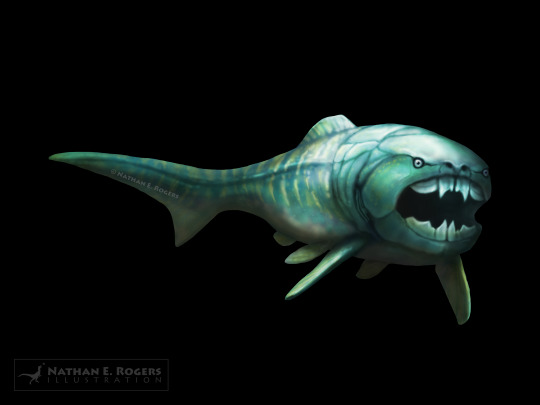
Dunkleosteus
Late Devonian
I had the great opportunity to work on this image for the Mace Brown Museum of Natural History at the College of Charleston, SC, with guidance from paleontologist Dr. Scott Persons.
You can watch a virtual tour of the Museum's exhibits at:
https://www.youtube.com/watch?v=zNZ9NcUeXAA&list=PL4-bAC0oaWu445vvKgvIqIxP8OCndikoV
#natural history#science#paleontology#paleoart#Illustration#dunkleosteus#arthrodire#placoderm#devonian#paleozoic#armored fish
116 notes
·
View notes
Photo

My colour palettes change pretty consistently across screens and the computer I do these on doesn’t match my other devices, which sucks. Usually I can live with it and the changes aren’t too drastic but these guys are some of my favourites and they suffered quite a bit. Not much to say beyond that but in this particular case I am bothered and I just wanted to rant a bit, I guess.
Anyway... These are my “Arctic Giants” and would be exceedingly rare end-game pokemon, probably version exclusive or maybe North/South exclusive. Ningant always looked like a haunted parka but I was inspired to add a dash of Umibozu, which you can see in action in the little vignette. Bergantic was made around ten years ago but to my relief wasn’t so similar to the current Ice/Water Dunkleosteus, Arctovish, as to be redundant or derivative. Following on from that thread i’m not such a masochist that I would give a pokemon with 160 Attack a move like Fishious Rend.
Ningant have been rumored in myth for centuries, if not millennia. Only recently were they confirmed to exist in reality, in the deepest reaches of the coldest oceans. The oceanographers that encountered the creature, deep in the inky blackness, confined to their tiny submersible described the encounter as terror in its most primal form. Two eyes, set in a face as big as the craft itself peered into the cockpit, into the pilots and froze their souls with a feeling of insignificance and helplessness one could only feel in the utter darkness of the coldest sea, alone and unreachable, under the gaze of a true giant.
Bergantic reside mostly in the upper reaches of the polar oceans, resting amongst the icebergs they are almost indistinguishable. Their enormous size and vicious nature allow them to dominate their environment where they typically prey on Walrein and Wailord, some of the few pokemon large enough to provide a suitable meal for the arctic giant. In more recent years, as tourism has made its way into the polar seas a new opportunity has presented itself for the Bergantic. Easily capable of ripping through the hull of any tourist liner the security on board these leisure cruises is taken with a deathly seriousness.
— Ability Info —
— Attack Info —
#auzz#saucylobster#fakemon#fakedex#ningyo#umibozu#yokai monsters#ghost#wraith#spectre#dunkleosteus#placoderm#arthrodire#fish#iceberg#ice floe#polar#arctic
31 notes
·
View notes
Photo

DUNK! DON'T EAT THE FLOWERS! There's a wedding at the Museum tonight and these HUGE arthrodire fish will eat just about anything! Time to get the spray bottle. Fun fact: Angiosperms (flowering plants) wouldn't evolve for another 100 million years during the Early Cretaceous Period. #fossilfriday #arthrodire #dunkleosteus #cleveland #cle #fossil #friday #fishyfriday #museumlife #notashark #bouquet #museumwedding #wedding #flower #whenyouworkatamuseum #wearestemsquad (at Cleveland Museum of Natural History)
#fishyfriday#cle#museumlife#museumwedding#fossilfriday#cleveland#bouquet#dunkleosteus#arthrodire#notashark#wearestemsquad#wedding#flower#friday#whenyouworkatamuseum#fossil
24 notes
·
View notes
Text
Life Finds a Way

In a series that I’m calling “Life Finds a Way,” I will be doing alphabetic moodboards for prehistoric creatures. Presented here are some creatures from A-D.

1. Ankylosaurus - Genus*- Armored dinosaur. Time- Late Cretaceous (68-66 million years ago). Length- 6 to 8 meters (20-26 ft). Weight - 4.8 to 8 metric tons.
2. Anomalacaris- Genus- Radiodont (Anomalacarid). Time- Early to mid Cambrian (Approx- 540 million years ago). Length - 1 m (3.3 ft). Weight- not known.
3. Brachiosaurus - Genus - Sauropod dinosaur. Time - Late Jurassic (154-153 million years ago). Length - 20-21 meters (66-69 ft). Height - 9.4 meters (30 3/4 ft). Weight - 28.7 metric tons (31.6 short tons)*
4. Baryonyx - Genus - Theropod dinosaur. Time - Early Cretaceous (130-125mya). Length - 7.5 and 10 m (25 and 33 ft). Weight - 1.2 and 1.9 t (1.3 and 2.1 short tons; 1.2 and 1.9 long tons).
*There have been many estimates for the weight of Brachiosaurs, based on the species chosen. I have selected one of the estimates.

1. Coelophysis - Genus -Theropod Dinosaur. Time- Late Triassic to Early Jurassic (216-196 mya). Length - 3 metres (9.8 ft). Weight- 15-20kg (33-44kg).
2. Carnotaurus - Genus - Theropod Dinosaur. Time - Late Cretaceous. (71mya). Length - 7.5–9 m (24.6–29.5 ft). Weight- 500 kg (1.5 long tons; 1.7 short tons).
3. Dracorex - Genus- Pachycephalosaurid Dinosaur. Time - Late Cretaceous (70-66 mya). (Dracorex is debated to be a juvenile Pachycephalosaurus. Therefore the estimates of its height and weight are varying. That’s why I have not included it).
4. Dunkleosteus- Genus- Arthrodire Placoderm fish. Time- Late Devonian (382-358 mya). Length- 8.79 m (28.8 ft). Weight- 4 t (4.4 short tons).
Keep an eye on this space for the next installment in the series.
*Genus- A genus (plural genera) is a taxonomic rank used in the biological classification of living and fossil organisms, as well as viruses,in biology. In the hierarchy of biological classification, genus comes above species and below family.
PS: Feel free to DM me if you want to know more.
13 notes
·
View notes